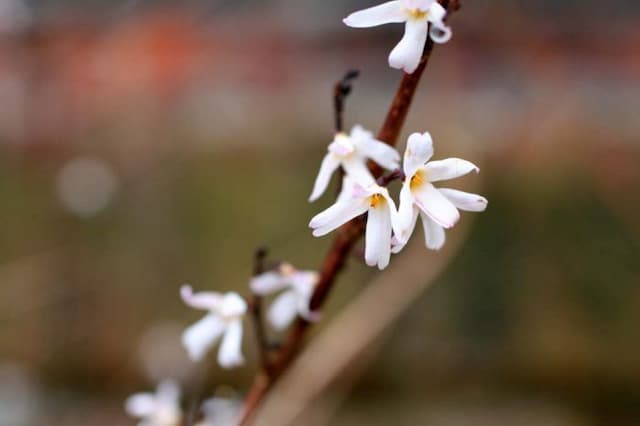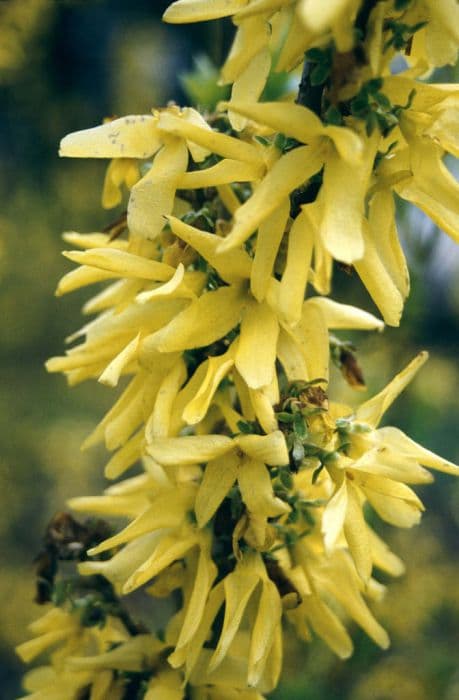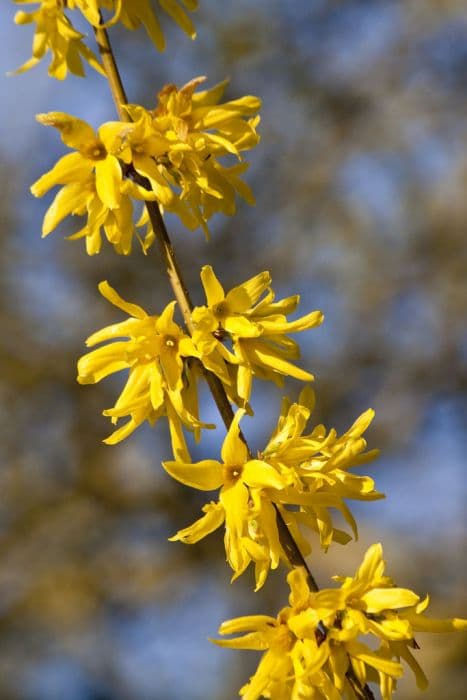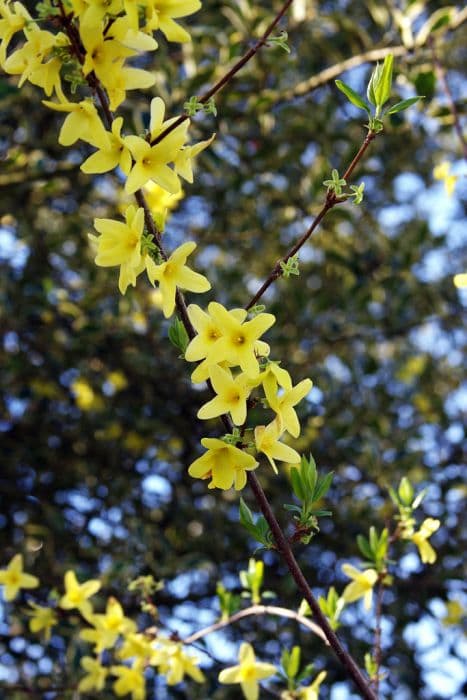Glossy Privet Ligustrum lucidum 'Excelsum Superbum' (v)

ABOUT
The plant commonly known as 'Excelsum Superbum' is known for its striking appearance, highlighted by its variegated leaves. The leaves themselves are glossy and oval-shaped. Each leaf boasts a mix of green colors with creamy white and yellow edges, providing a bright and eye-catching contrast. These leaves grow densely, giving the plant a lush, full look. Throughout the year, the variegation adds a colorful accent to gardens. The plant also produces clusters of small, white flowers that can add a fragrant dimension to its surroundings, although flowering is not the primary ornamental feature of this cultivar. Overall, the plant's presentation is elegant and can act as an attractive feature in various garden settings, either as a stand-alone specimen or as part of a hedge or border.
About this plant
 Names
NamesFamily
Oleaceae.
Synonyms
Glossy Privet, Wax-Leaf Privet, Tree Privet.
Common names
Ligustrum lucidum 'Tricolor', Ligustrum lucidum 'Variegatum'.
 Toxicity
ToxicityTo humans
The common name for Ligustrum lucidum 'Excelsum Superbum' (v) is glossy privet. This plant is considered to be toxic to humans if ingested. The primary toxic components are ligustrin and syringin, which are found in the berries and leaves. Symptoms of poisoning may include nausea, vomiting, abdominal pain, diarrhea, and in severe cases, seizures or central nervous system depression. Prolonged exposure or consumption could potentially result in more serious health consequences.
To pets
Glossy privet, the common name for Ligustrum lucidum 'Excelsum Superbum' (v), is toxic to pets as well. Cats and dogs that ingest parts of this plant, especially the berries, may experience symptoms such as diarrhea, vomiting, loss of appetite, and abdominal pain. In severe cases, ingestion could lead to coordination issues, increased heart rate, weakness, and potentially seizures. It's crucial to prevent pets from ingesting parts of this plant due to these potential health risks.
 Characteristics
CharacteristicsLife cycle
Perennials
Foliage type
Evergreen
Color of leaves
Variegated
Flower color
White
Height
8-12 feet (2.4-3.7 meters)
Spread
4-6 feet (1.2-1.8 meters)
Plant type
Shrub
Hardiness zones
8
Native area
China
Benefits
 General Benefits
General Benefits- Ornamental appeal: Its variegated leaves add aesthetic value to landscapes and gardens.
- Ease of cultivation: Adaptable to a wide range of soil types and handles pruning well, making it suitable for hedges and screens.
- Drought tolerance: Once established, it can withstand periods of low water availability.
- Pest resistance: Generally resistant to pests and diseases, reducing the need for chemical treatments.
- Privacy screen: It can grow into a dense hedge, providing privacy and reducing noise from surroundings.
- Shade provision: Larger specimens can provide shade in gardens and outdoor spaces.
- Wildlife support: Its flowers can attract pollinators, while the berries may provide food for birds.
- Year-round interest: Evergreen in nature, it maintains its foliage throughout the seasons, ensuring constant garden interest.
 Medical Properties
Medical Properties- Anti-inflammatory properties: Chinese Privet is traditionally used to reduce inflammation in various conditions.
- Hepatoprotective effects: It has been suggested to offer some protection for the liver from certain toxins.
- Antibacterial activity: Extracts from the plant have demonstrated antibacterial properties in some studies.
- Antioxidant effects: Chinese Privet is known to contain antioxidants that can help in preventing cell damage from free radicals.
- Anti-tumor properties: There is some evidence to suggest that compounds in Chinese Privet may possess properties that inhibit tumor growth.
 Air-purifying Qualities
Air-purifying QualitiesThis plant is not specifically known for air purifying qualities.
 Other Uses
Other Uses- The glossy privet can be used as a natural dye, with its leaves and berries providing shades of yellow, green, or black depending on the mordant used.
- Wood from glossy privet trees can be used for crafting small wooden items such as handles, carvings, or instruments due to its fine grain and workability.
- Glossy privet hedges can act as noise barriers in urban environments, helping to reduce traffic and city noise when planted densely along roads or property lines.
- The dense canopy of glossy privet is ideal for creating shaded garden paths or arbors, providing relief from the sun in hotter climates.
- Glossy privet can be used in topiary art, with its fast growth and dense foliage making it suitable for shaping into intricate designs.
- Dead and pruned wood from glossy privet can be repurposed as fuel for firewood, providing a source of renewable energy.
- Leaves from the glossy privet can be used to create a natural insect repellent by crushing them and applying the extract or using them in sachets.
- In areas where invasive, the glossy privet's vigorous growth can provide quick ground cover to stabilize soil and prevent erosion until native plants can be established.
- Fallen glossy privet leaves can be collected and used as mulch in garden beds, providing nutrients as they decompose and suppressing weed growth.
- The reflective property of the glossy leaves can be strategically used to brighten up dim areas by reflecting sunlight into desired spots in the garden.
Interesting Facts
 Feng Shui
Feng ShuiThe Glossy Privet is not used in Feng Shui practice.
 Zodiac Sign Compitability
Zodiac Sign CompitabilityThe Glossy Privet is not used in astrology practice.
 Plant Symbolism
Plant Symbolism- Protection: This plant, commonly known as Glossy Privet, often symbolizes protection due to its dense foliage which can create privacy and act as a natural barrier.
- Longevity: Glossy Privet has a robust and long-living nature which makes it represent endurance and the ability to withstand the test of time.
- Purity: The bright, glossy leaves of the Glossy Privet can be associated with cleanliness and purity.
- Privacy: Due to its use as a hedge for privacy, the Glossy Privet can signify the importance of maintaining personal space and boundaries.
- Renewal: Since Glossy Privet can be pruned heavily and still regrow, it may symbolize rebirth or starting anew.
 Water
WaterThe Glossy Privet (Ligustrum lucidum 'Excelsum Superbum') should be watered deeply but infrequently to encourage a strong root system. Aim for about 1 inch of water per week, either through rainfall or supplemental watering with a garden hose or drip system. This can equate to roughly 0.5 gallons per square foot every week during the growing season, tapering off in the fall and winter when the plant's water needs decrease. If the weather is particularly hot or dry, you may need to water twice a week, but always check the soil moisture first—Glossy Privet doesn’t like to sit in soggy soil.
 Light
LightGlossy Privet thrives in full sun to partial shade, with at least six hours of direct sunlight a day for optimal growth. They can tolerate some shade, but too much can lead to sparse foliage and reduced vigor. A location receiving morning sunlight and afternoon shade or dappled sunlight throughout the day is also suitable for this variegated cultivar to maintain its leaf coloration.
 Temperature
TemperatureGlossy Privet is hardy and can endure a range of temperatures, but prefers a consistent range between 40°F and 95°F. It can survive brief periods of colder temperatures down to about 10°F, but frost can damage the foliage and stems. The ideal temperature for vigorous growth and health is between 60°F and 80°F.
 Pruning
PruningGlossy Privet should be pruned to maintain shape and encourage bushier growth. The best time for heavy pruning is in late winter or early spring before new growth starts. Throughout the growing season, light trimming can be done to remove any irregular or damaged branches. Regular pruning helps maintain the variegation of the leaves and promotes the overall health of the plant.
 Cleaning
CleaningAs needed
 Soil
SoilGlossy privet 'Excelsum Superbum' thrives in well-draining soil with a moderate fertility level and a pH range from 6.5 to 7.5. A balanced mix of loamy soil, compost, and perlite or sand can provide the ideal structure and nutrition for this variegated privet.
 Repotting
RepottingGlossy privet 'Excelsum Superbum' should be repotted once every 2 to 3 years to refresh the soil and accommodate root growth. Young plants may require more frequent repotting, whereas mature plants can be repotted less often.
 Humidity & Misting
Humidity & MistingGlossy privet 'Excelsum Superbum' is adaptable and tolerant of a wide range of humidity levels but prefers a moderate to high humidity environment, generally around 40-60%.
 Suitable locations
Suitable locationsIndoor
Place in bright, indirect light; water when soil feels dry.
Outdoor
Sun to partial shade; protect from extreme cold.
Hardiness zone
8-10 USDA
 Life cycle
Life cycleLigustrum lucidum 'Excelsum Superbum', commonly known as Glossy Privet, starts its life as a seed, which after being planted, germinates and sprouts into a seedling. The seedling grows into a juvenile plant, where it develops a root system and foliage but has not yet matured to produce flowers. As it matures into an adult plant, it begins vegetative growth of stems and leaves in a bushy or tree-like form and eventually blooms, producing white flowers that are often arranged in panicles. After pollination, these flowers develop into small, purple to black berries which contain seeds for the next generation. The plant continues to grow and can reach a considerable height, often used in landscaping for hedging or as a standalone ornamental tree. Over time, the Glossy Privet may experience senescence, where growth declines and it eventually dies, completing its life cycle.
 Propogation
PropogationPropogation time
Spring-Early Summer
The Chinese Privet 'Excelsum Superbum' (scientific name Ligustrum lucidum 'Excelsum Superbum') is often propagated through semi-hardwood cuttings. This method is typically carried out during the late summer months, as this is when the current season's growth has started to mature but is not yet fully hardened. To propagate by this method, a gardener would cut a 4 to 6 inch (approximately 10 to 15 cm) length of semi-hardwood stem that includes several leaves. The bottom end of the cutting should be stripped of its lower leaves and then dipped in rooting hormone powder to encourage root growth. Afterward, the prepared cutting is planted in a well-draining soil mix, ensuring that the node where the bottom leaves were removed is buried, as this is where roots are most likely to develop. The cuttings should be kept in a humid environment with indirect light until roots have developed, after which they can be transplanted to their final location.







